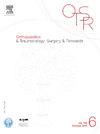Machine learning models based on a national-scale cohort accurately identify patients at high risk of deep vein thrombosis following primary total hip arthroplasty
IF 2.3
3区 医学
Q2 ORTHOPEDICS
引用次数: 0
Abstract
Background
The occurrence of deep venous thrombosis (DVT) following total hip arthroplasty (THA) poses a substantial risk of morbidity and mortality, highlighting the need for preoperative risk stratification and prophylaxis initiatives. However, there exists a paucity of big-data-driven predictive models for DVT risk following elective hip arthroplasty. Therefore, this study aimed to develop and assess machine learning (ML) models in predicting DVT risk following THA using a national patient cohort.
Hypothesis
We hypothesized that machine learning models would accurately predict patient-specific DVT risk in patients undergoing elective total hip arthroplasty.
Patients and methods
The ACS-NSQIP national database was queried to identify 70,733 THA patients from 2013 to 2020, including 317 patients (0.45%) with DVT. Artificial neural network, random forest, histogram-based gradient boosting, k-nearest neighbor, and support vector machine algorithms were trained and utilized to predict the risk of DVT following THA. Model performance was assessed using discrimination, calibration, and potential clinical utility.
Results
Histogram-based gradient boosting demonstrated the best prediction performance with an area under the receiver operating curve of 0.93 (discrimination), a slope of 0.92 (closely aligned with actual outcomes), an intercept of 0.18 (minimal prediction bias), and a Brier score of 0.010 (high accuracy). The model also demonstrated clinical utility with greater net benefit than alternative decision criteria in the decision curve analysis. Length of stay, international normalized ratio, age, and partial thromboplastin time were the strongest predictors of DVT after primary THA.
Discussion
Machine learning models demonstrated excellent predictive performance in terms of discrimination, calibration, and decision curve analysis. Further research is warranted in terms of external validation to realize the potential of these algorithms as a valuable adjunct tool for risk stratification in patients undergoing THA.
Level of evidence
III; Retrospective study.
基于全国范围队列的机器学习模型准确识别原发性全髋关节置换术后深静脉血栓形成的高风险患者。
背景:全髋关节置换术(THA)后发生深静脉血栓形成(DVT)有很大的发病率和死亡率风险,突出了术前风险分层和预防措施的必要性。然而,对于选择性髋关节置换术后DVT风险,目前缺乏大数据驱动的预测模型。因此,本研究旨在开发和评估机器学习(ML)模型在全髋关节置换术后DVT风险预测中的应用。假设:我们假设机器学习模型可以准确预测选择性全髋关节置换术患者的特定DVT风险。患者和方法:查询ACS-NSQIP国家数据库,2013 - 2020年共发现70,733例THA患者,其中317例(0.45%)伴有DVT。人工神经网络、随机森林、基于直方图的梯度增强、k近邻和支持向量机算法被训练并用于预测THA后DVT的风险。通过鉴别、校准和潜在的临床应用来评估模型的性能。结果:基于直方图的梯度增强预测效果最佳,受试者工作曲线下面积为0.93(判别),斜率为0.92(与实际结果非常接近),截距为0.18(预测偏差最小),Brier评分为0.010(准确度高)。在决策曲线分析中,该模型也证明了比其他决策标准具有更大净效益的临床效用。住院时间、国际标准化比率、年龄和部分凝血活素时间是原发性THA后DVT的最强预测因子。讨论:机器学习模型在辨别、校准和决策曲线分析方面表现出出色的预测性能。在外部验证方面需要进一步的研究,以实现这些算法作为THA患者风险分层有价值的辅助工具的潜力。证据等级:III;回顾性研究。
本文章由计算机程序翻译,如有差异,请以英文原文为准。
求助全文
约1分钟内获得全文
求助全文
来源期刊
CiteScore
5.10
自引率
26.10%
发文量
329
审稿时长
12.5 weeks
期刊介绍:
Orthopaedics & Traumatology: Surgery & Research (OTSR) publishes original scientific work in English related to all domains of orthopaedics. Original articles, Reviews, Technical notes and Concise follow-up of a former OTSR study are published in English in electronic form only and indexed in the main international databases.

 求助内容:
求助内容: 应助结果提醒方式:
应助结果提醒方式:


